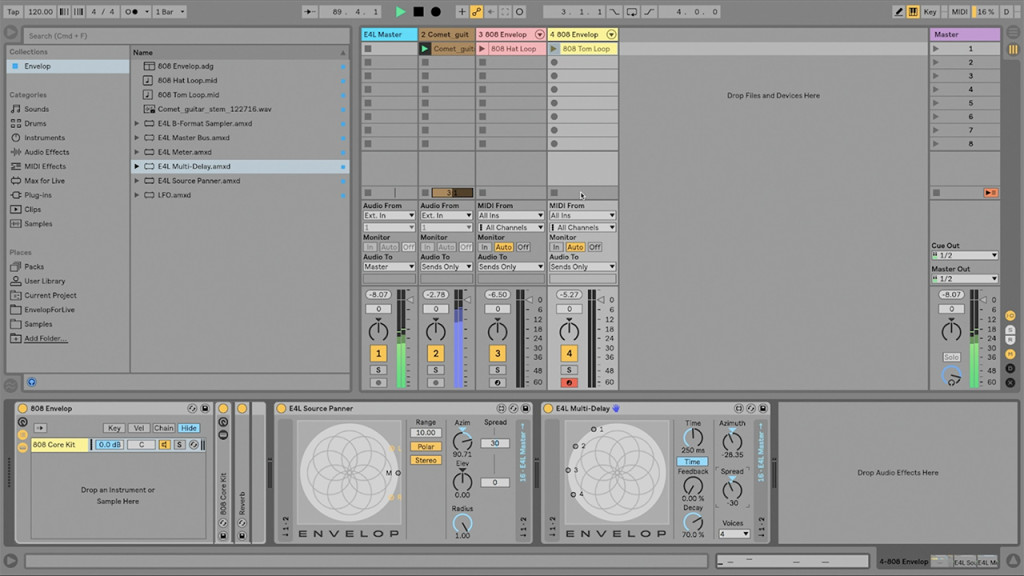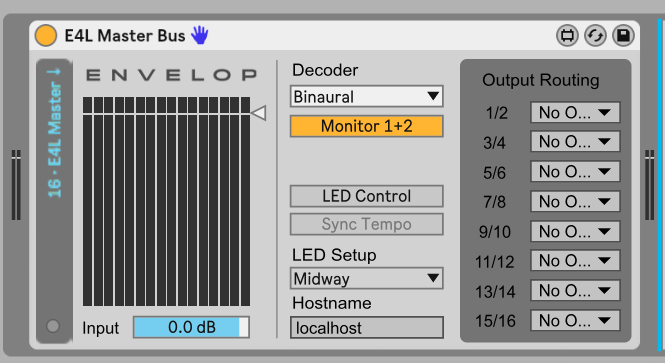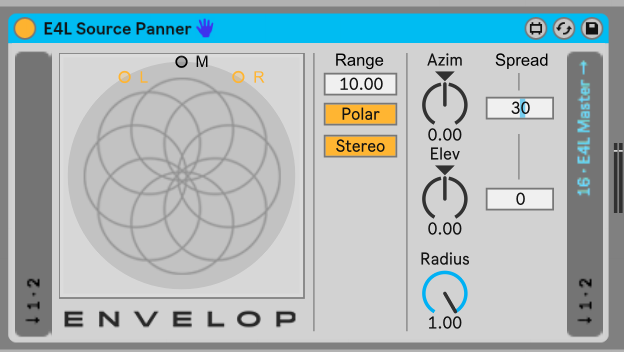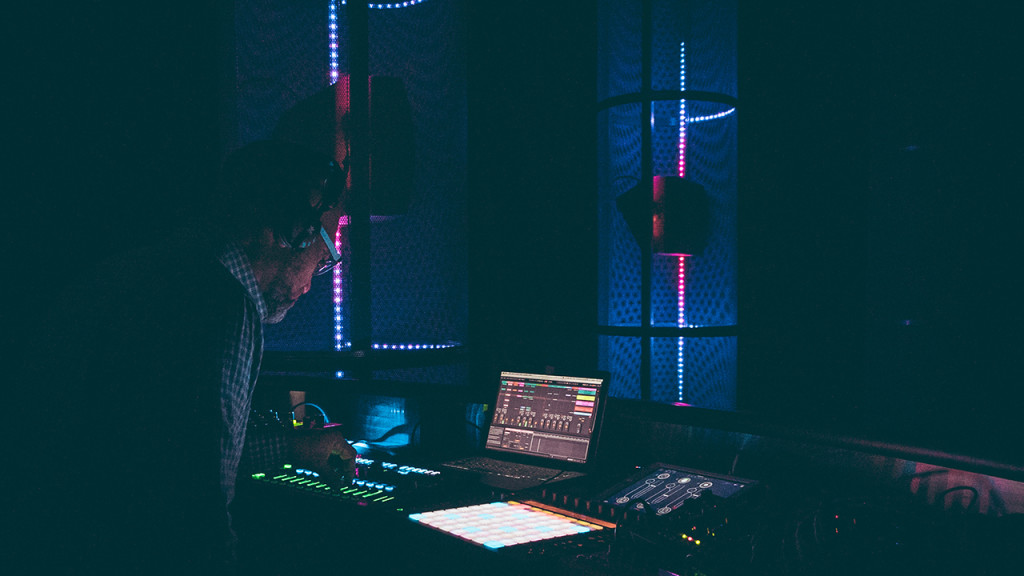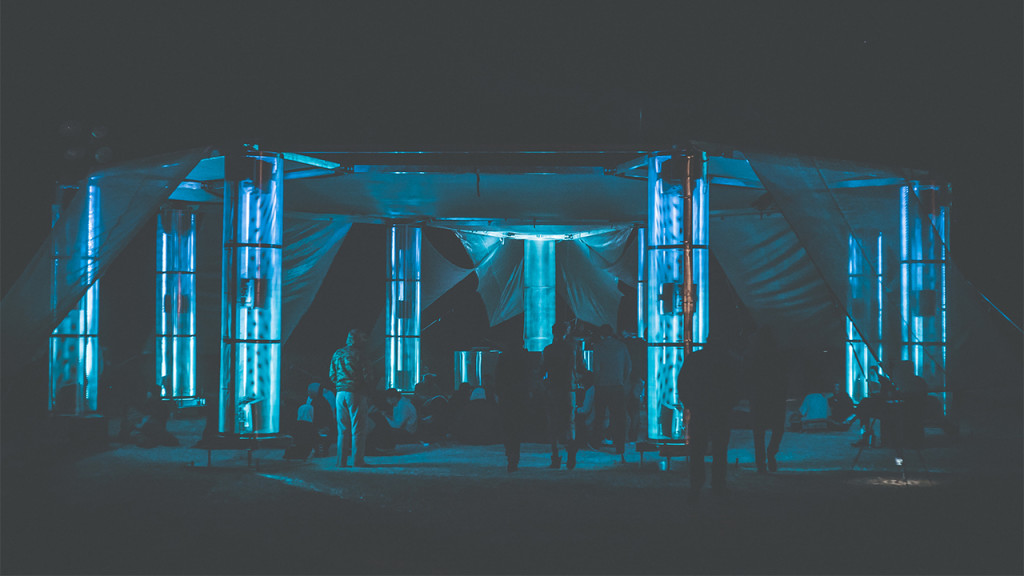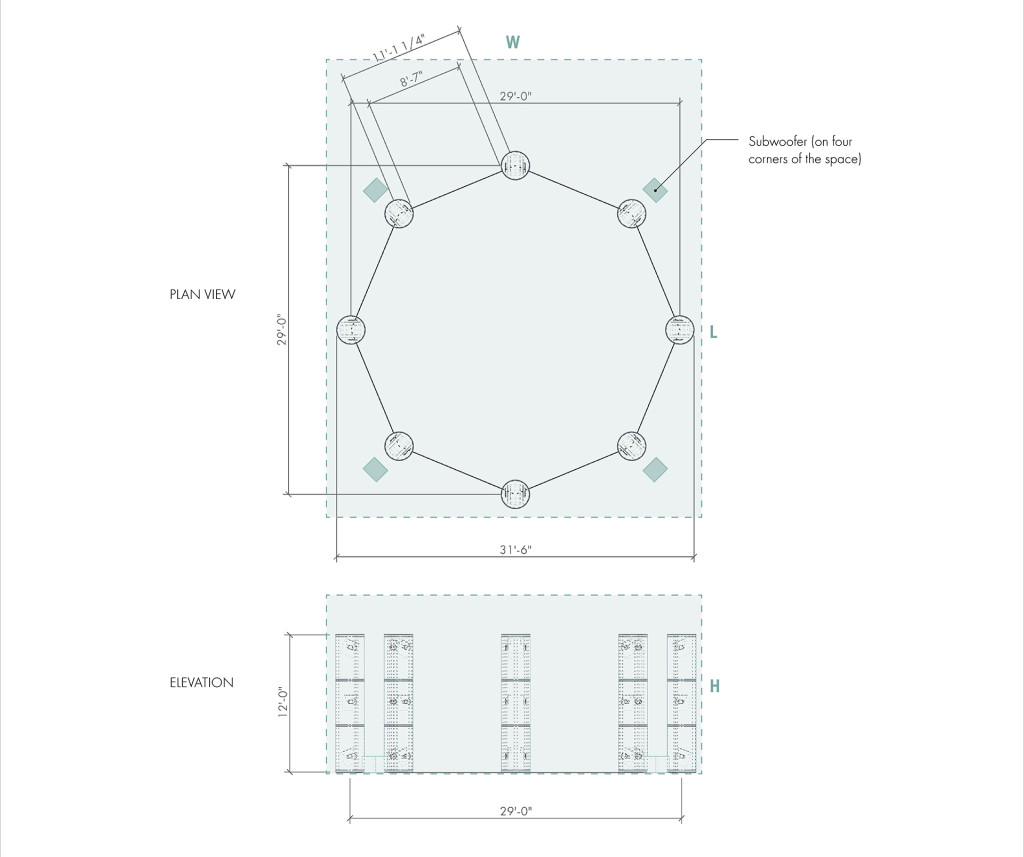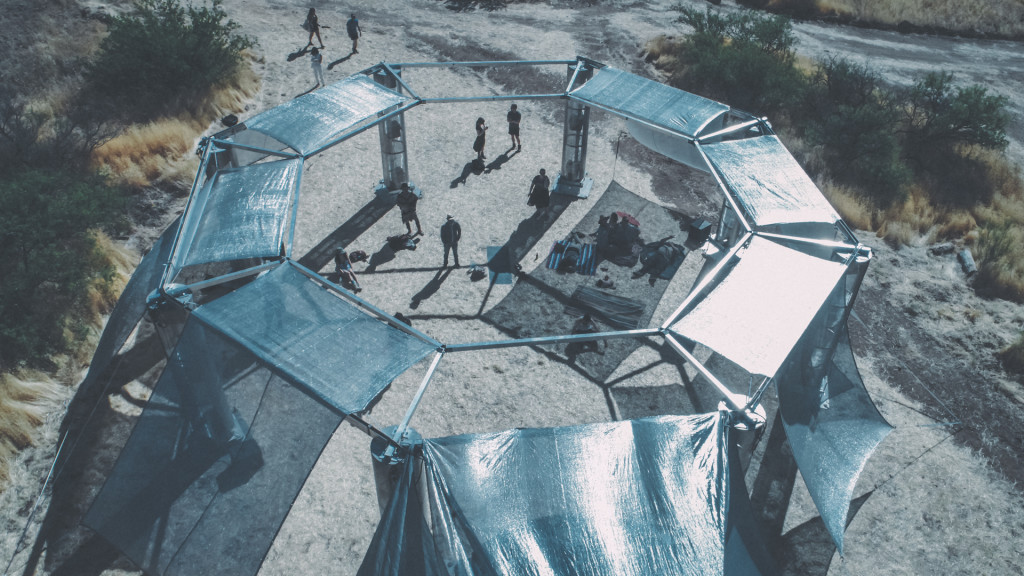Envelop began life by opening a space for exploring 3D sound. But today, the nonprofit, directed by artist Christopher Willits, is also releasing a set of free spatial sound tools you can use in Ableton Live 10. We’ve got an exclusive first look.
First, let’s back up. Listening to sound in three dimensions is not just some high-tech gimmick. It’s how you hear naturally with two ears. The way that actually works is complex – the Wikipedia overview alone is dense – but close your eyes, tilt your head a little, and listen to what’s around you. Space is everything.
And just as in the leap from mono to stereo, space can change a musical mix – it allows clarity and composition of sonic elements in a new way, which can transform its impact. So it really feels like the time is right to add three dimensions to the experience of music and sound, personally and in performance.
Intuitively, 3D sound seems even more natural than visual counterparts. You don’t need to don weird new stuff on your head, or accept disorienting inputs, or rely on something like 19th century stereoscopic illusions. Sound is already as ephemeral as air (quite literally), and so, too, is 3D sound.
So, what’s holding us back?
Well, stereo sound required a chain of gear, from delivery to speaker. But those delivery mechanisms are fast evolving for 3D, and not just in terms of proprietary cinema setups.
But stereo audio also required something else to take off: mixers with pan pots. Stereo effects. (Okay, some musicians still don’t know how to use this and leave everything dead center, but that only proves my point.) Stereo only happened because tools made its use accessible to musicians.
Looking at something like Envelop’s new tools for Ableton Live 10, you see something like the equivalent of those first pan pots. Add some free devices to Live, and you can improvise with space, hear the results through headphones, and scale up to as many speakers as you want, or deliver to a growing, standardized set of virtual reality / 3D / game / immersive environments.
And that could open the floodgates for 3D mixing music. (Maybe even it could open your own floodgates there.)
Envelop tools for Live 10
Today, Envelop for Live (E4L) has hit GitHub. It’s not a completely free set of tools – you need the full version of Ableton Live Suite. Live 10 minimum is required (since it provides the requisite set of multi-point audio plumbing.) Provided you’re working from that as a base, though, musicians get a set of Max for Live-powered devices for working with spatial audio production and live performance, and developers get a set of tools for creating their own effects.
Start here for the download:
http://www.envelop.us/software/
See also the more detailed developer site:
https://github.com/EnvelopSound/EnvelopForLive/
Read an overview of the system, and some basic explanations of how it works (including some definitions of 3D sound terminology):
https://github.com/EnvelopSound/EnvelopForLive/wiki/System-Overview
And then find a getting started guide, routing, devices, and other reference materials on the wiki:
https://github.com/EnvelopSound/EnvelopForLive/wiki
It’s beautiful, elegant software – the friendliest I’ve seen yet to take on spatial audio, and very much in the spirit of Ableton’s own software. Kudos to core developers Mark Slee, Roddy Lindsay, and Rama Gotfried.
Here’s the basic idea of how the whole package works.
Output. There’s a Master Bus device that stands in for your output buses. It decodes your spatial audio, and adapts routing to however many speakers you’ve got connected – whether that’s just your headphones or four speakers or a huge speaker array. (That’s the advantage of having a scalable system – more on that in a moment.)
Sources. Live 10’s Mixer may be built largely with the idea of mixing tracks down to stereo, but you probably already think of it sort of as a set of particular musical materials – as sources. The Source Panner device, added to each track, lets you position that particular musical/sonic entity in three-dimensional space.
Processors. Any good 3D system needs not only 3D positioning, but also separate effects and tools – because normal delays, reverbs, and the like presume left/right or mid/side stereo output. (Part of what completes the immersive effect is hearing not only the positioning of the source, but reflections around it.)
In this package, you get:
Spinner: automates motion in 3D space horizontally and with vertical oscillations
B-Format Sampler: plays back existing Ambisonics wave files (think samples with spatial information already encoded in them)
B-Format Convolution Reverb: imagine a convolution reverb that works with three-dimensional information, not just two-dimensional – in other words, exactly what you’d want from a convolution reverb
Multi-Delay: cascading, three-dimensional delays out of a mono source
HOA Transform: without explaining Ambisonics, this basically molds and shapes the spatial sound field in real-time
Meter: Spatial metering. Cool.
Envelop SF and Envelop Satellite venues also have some LED effects, so you’ll find some devices for controlling those (which might also be useful templates for stuff you’re doing).
All of this spatial information is represented via a technique called Ambisonics. Basically, any spatial system – even stereo – involves applying some maths to determine relative amplitude and timing of a signal to create particular impressions of space and depth. What sets Ambisonics apart is, it represents the spatial field – the sphere of sound positions around the listener – separately from the individual speakers. So you can imagine your sound positions existing in some perfect virtual space, then being translated back to however many speakers are available.
This scalability really matters. Just want to check things out with headphones? Set your master device to “binaural,” and you’ll get a decent approximation through your headphones. Or set up four speakers in your studio, or eight. Or plug into a big array of speakers at a planetarium or a cinema. You just have to route the outputs, and the software decoding adapts.
Envelop is by no means the first set of tools to help you do this – the technique dates back to the 70s, and various software implementations have evolved over the years, many of them free – but it is uniquely easy to use inside Ableton Live.
Open source, standards
Free software. It’s significant that Envelop’s tools are available as free and open source. Max/MSP, Max for Live, and Ableton Live are proprietary tools, but the patches and externals exist independently, and a free license means you’re free to learn from or modify the code and patches. Plus, because they’re free in cost, you can share your projects across machines and users, provided everybody’s on Live 10 Suite.
Advanced Max/MSP users will probably already be familiar with the basic tools on which the Envelop team have built. They’re the work of the Institute for Computer Music and Sound Technology, at the Zürcher Hochschule der Künste in Zurich, Switzerland. ICMST have produced a set of open source externals for Max/MSP:
https://www.zhdk.ch/downloads-ambisonics-externals-for-maxmsp-5381
Their site is a wealth of research and other free tools, many of them additionally applicable to fully free and open source environments like Pure Data and Csound.
But Live has always been uniquely accessible for trying out ideas. Building a set of friendly Live devices takes these tools and makes them make more sense in the Live paradigm.
Non-proprietary standards. There’s a strong push to proprietary techniques in spatial audio in the cinema – Dolby, for instance, we’re looking at you. But while proprietary technology and licensing may make sense for big cinema distributors, it’s absolute death for musicians, who likely want to tour with their work from place to place.
The underlying techniques here are all fully open and standardized. Ambisonics work with a whole lot of different 3D use cases, from personal VR to big live performances. By definition, they don’t define the sound space in a way that’s particular to any specific set of speakers, so they’re mobile by design.
The larger open ecosystem. Envelop will make these tools new to people who haven’t seen them before, but it’s also important that they share an approach, a basis in research, and technological compatibility with other tools.
That includes the German ZKM’s Zirkonium system, HoaLibrary (that repository is deprecated but links to a bunch of implementations for Pd, Csound, OpenFrameworks, and so on), and IRCAM’s SPAT. All these systems support ambisonics – some support other systems, too – and some or all components include free and open licensing.
I bring that up because I think Envelop is stronger for being part of that ecosystem. None of these systems requires a proprietary speaker delivery system – though they’ll work with those cinema setups, too, if called upon to do so. Musical techniques, and even some encoded spatial data, can transfer between systems.
That is, if you’re learning spatial sound as a kind of instrument, here you don’t have to learn each new corporate-controlled system as if it’s a new instrument, or remake your music to move from one setting to another.
Envelop, the physical version
You do need compelling venues to make spatial sound’s payoff apparent – and Envelop are building their own venues for musicians. Their Envelop SF venue is a permanent space in San Francisco, dedicated to spatial listening and research. Envelop Satellite is a mobile counterpart to that, which can tour festivals and so on.
Envelop SF: 32 speakers with speakers above. 24 speakers set in 3 rings of 8 (the speakers in the columns) + 4 subs, and 4 ceiling speakers. (28.4)
Envelop Satellite: 28 speakers. 24 in 3 rings + 4 subs (overhead speakers coming soon) (24.4)
The competition, as far as venues: 4DSOUND and Berlin’s Monom, which houses a 4DSOUND system, are similar in function, but use their own proprietary tools paired with the system. They’ve said they plan a mobile system, but no word on when it will be available. The Berlin Institute of Sound and Music’s Hexadome uses off-the-shelf ZKM and IRCAM tools and pairs projection surfaces. It’s a mobile system by design, but there’s nothing particularly unique about its sound array or toolset. In fact, you could certainly use Envelop’s tools with any of these venues, and I suspect some musicians will.
One thing I haven’t fully tested is CPU load of these different solutions on different machines. 4DSOUND I believe rewrote a lot of their DSP processing for efficiency – that may be something Envelop for Live could employ, too. These other solutions may in turn also have varying degrees of resource consumption.
There are also many multi-speaker arrays housed in music venues, immersive audiovisual venues, planetariums, cinemas, and so on. So long as you can get access to multichannel interfacing with those systems, you could use Envelop for Live with all of these. The only obstacle, really, is whether these venues embrace immersive, 3D programming and live performance.
But if you thought you had to be Brian Eno to get to play with this stuff, that’s not likely to be the situation for long.
VR, AR, and beyond
In addition to venues, there’s also a growing ecosystem of products for production and delivery, one that spans musical venues and personal immersive media.
To put that more simply: after well over a century of recording devices and production products assuming mono or stereo, now they’re also accommodating the three dimensions your two ears and brain have always been able to perceive. And you’ll be able to enjoy the results whether you’re on your couch with a headset on, or whether you prefer to go out to a live venue.
Ambisonics-powered products now include Facebook 360, Google VR, Waves, GoPro, and others, with more on the way, for virtual and augmented reality. So you can use Live 10 and Envelop for Live as a production tool for making music and sound design for those environments.
Steinberg are adopting ambisonics, too (via Nuendo). Here’s Waves’ guide – they now make plug-ins that support the format, and this is perhaps easier to follow than the Wikipedia article (and relevant to Envelop for Live, too):
https://www.waves.com/ambisonics-explained-guide-for-sound-engineers
Ableton Live with Max for Live has served as an effective prototyping environment for audio plug-ins, too. So developers could pick up Envelop for Live’s components, try out an idea, and later turn that into other software or hardware.
I’m personally excited about these tools and the direction of live venues and new art experiences – well beyond what’s just in commercial VR and gaming. And I’ve worked enough on spatial audio systems to at least say, there’s real potential. I wouldn’t want to keep stereo panning to myself, so it’s great to get to share this with you, too. Let us know what you’d like to see in terms of coverage, tutorial or otherwise, and if there’s more you want to know from the Envelop team.
Thanks to Christopher Willits for his help on this.
More to follow…
https://github.com/EnvelopSound/EnvelopForLive/
Further reading
Inside a new immersive AV system, as Brian Eno premieres it in Berlin [Extensive coverage of the Hexadome system and how it works]
Here’s a report from the hacklab on 4DSOUND I co-hosted during Amsterdam Dance Event in 2014 – relevant to these other contexts, having open tools and more experimentation will expand our understanding of what’s possible, what works, and what doesn’t work:
Spatial Sound, in Play: Watch What Hackers Did in One Weekend with 4DSOUND
And some history and reflection on the significance of that system:
Spatial Audio, Explained: How the 4DSOUND System Could Change How You Hear [Videos]
Plus, for fun, here’s Robert Lippok [Raster] and me playing live on that system and exploring architecture in sound, as captured in a binaural recording by Frank Bretschneider [also Raster] during our performance for 2014 ADE. Binaural recording of spatial systems is really challenging, but I found it interesting in that it created its own sort of sonic entity. Frank’s work was just on the Hexadome.
One thing we couldn’t easily do was move that performance to other systems. Now, this begins to evolve.
